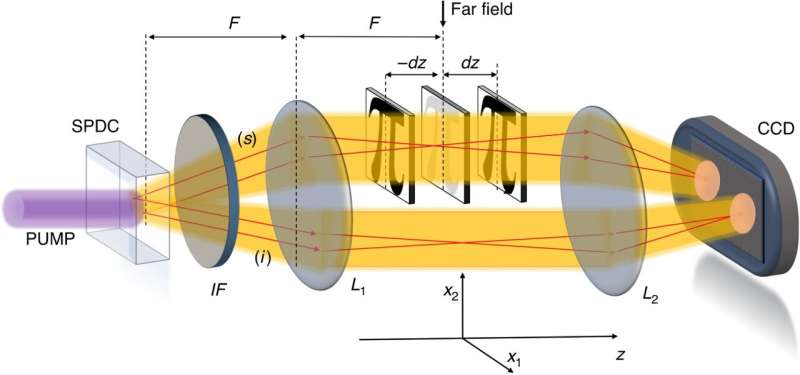 Scheme of the NIQPR. Two correlated beams labeled signal (s) and idler (i) are generated by the spontaneous parametric down conversion (SPDC) pumped by a CW laser @405 nm and propagate through an imaging system composed of two lenses (L1 is the far field lens with focal length F = 1 cm and L2 is the imaging lens with focal length of 3 cm) and a test object. An interference filter (IF) is used to select a bandwidth of 40 nm around the degenerate wavelength (@810 nm) and to block the pump. L2 images the far field plane on the camera chip with a magnification factor of about 8. The object is placed near to the far field of the source, and only the probe beam interacts with it. Phase information can be retrieved from intensity measurements taken at some out of focus (±dz) planes. Credit: Light: Science & Applications (2023). DOI: 10.1038/s41377-023-01215-1
Scheme of the NIQPR. Two correlated beams labeled signal (s) and idler (i) are generated by the spontaneous parametric down conversion (SPDC) pumped by a CW laser @405 nm and propagate through an imaging system composed of two lenses (L1 is the far field lens with focal length F = 1 cm and L2 is the imaging lens with focal length of 3 cm) and a test object. An interference filter (IF) is used to select a bandwidth of 40 nm around the degenerate wavelength (@810 nm) and to block the pump. L2 images the far field plane on the camera chip with a magnification factor of about 8. The object is placed near to the far field of the source, and only the probe beam interacts with it. Phase information can be retrieved from intensity measurements taken at some out of focus (±dz) planes. Credit: Light: Science & Applications (2023). DOI: 10.1038/s41377-023-01215-1Optical phase retrieval and imaging appear in a wide variety of science fields, such as imaging of quasi-transparent biological samples or nanostructures metrological characterization, for example, in the semiconductor industry. At a fundamental level, the limit to imaging accuracy in classical systems comes from the intrinsic fluctuation of the illuminating light, since the photons that form it are emitted randomly by conventional sources and behave independently of one another.
Quantum correlation in light beams, in which photons show certain cooperation, can surpass those limits. Although quantum advantage obtained in phase estimation through first-order interference is well understood, interferometric schemes are not suitable for multi-parameter wide-field imaging, requiring raster scanning for extended samples.
In a new paper published in Light: Science & Application, a team of scientists from the Quantum Optics Group of the Italian National Metrology Institute (INRiM), Italy, and from the Imaging Physics Dept. Optics Research Group, Faculty of Applied Sciences of Delft University of Technology, The Netherlands, has developed a technology exploiting quantum correlations to enhance imaging of phase profiles in a non-interferometric way.
The scheme proposed can be directly applied to wide-field transmission microscopy settings, to obtain a full-field phase retrieval in real time, and it is intrinsically more stable than an interferometric setup. The sensitivity enhancement has the potential to retrieve more information from samples than classically allowed at a fixed photon exposure, or equivalently, at a fixed measurement time.
The two main ingredients used by the scientists are the so-called “transport of intensity equation” (TIE) phase-retrieval, a well-explored algorithm in the classical domain to retrieve phase information from intensity direct measurements; and pair of entangled light beams. The quantum correlations among the two beams are so strong that they are identical at the single-photon level. The researchers used this correlation to reduce the intrinsic noise fluctuations of the probing light, obtaining a sharper image and more accurate phase estimation.
“Quantum resources such as entanglement and squeezing have been proven useful to enhance a variety of sensing applications, such as imaging, interferometric phase estimation, target detection and ranging among others. Our proposal brings another contribution to this wide panorama by showing that the very well-studied TIE phase-retrieval classical scheme can be significantly boosted by using quantum correlations nowadays routinely available in laboratories, showing potential for relatively short-term applications,” the scientists remarked.
More information:
Giuseppe Ortolano et al, Quantum enhanced non-interferometric quantitative phase imaging, Light: Science & Applications (2023). DOI: 10.1038/s41377-023-01215-1
Citation:
Quantum-enhanced non-interferometric quantitative phase imaging (2023, August 1)
retrieved 1 August 2023
from https://phys.org/news/2023-08-quantum-enhanced-non-interferometric-quantitative-phase-imaging.html
This document is subject to copyright. Apart from any fair dealing for the purpose of private study or research, no
part may be reproduced without the written permission. The content is provided for information purposes only.

